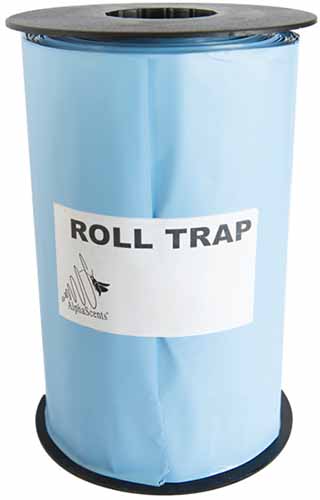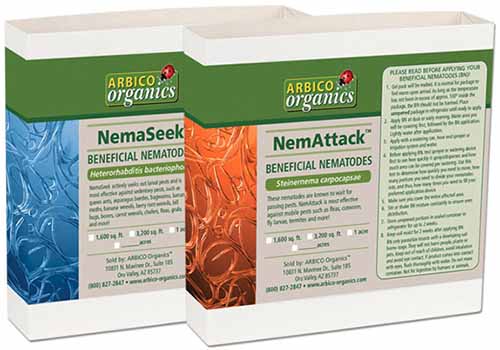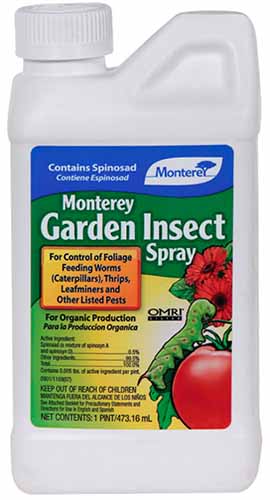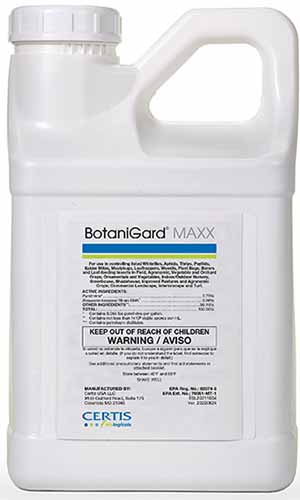Part of what I love about my plum trees is that I don’t have to worry about them like I do many of my other fruit trees.
Don’t get me wrong, I love peaches and apples, but they sure are high-maintenance in comparison to plums. But even undemanding plum trees can be plagued by pests now and then.
Sometimes, these pests are nothing more than a nuisance. Other times, they can threaten the life of the plum tree.
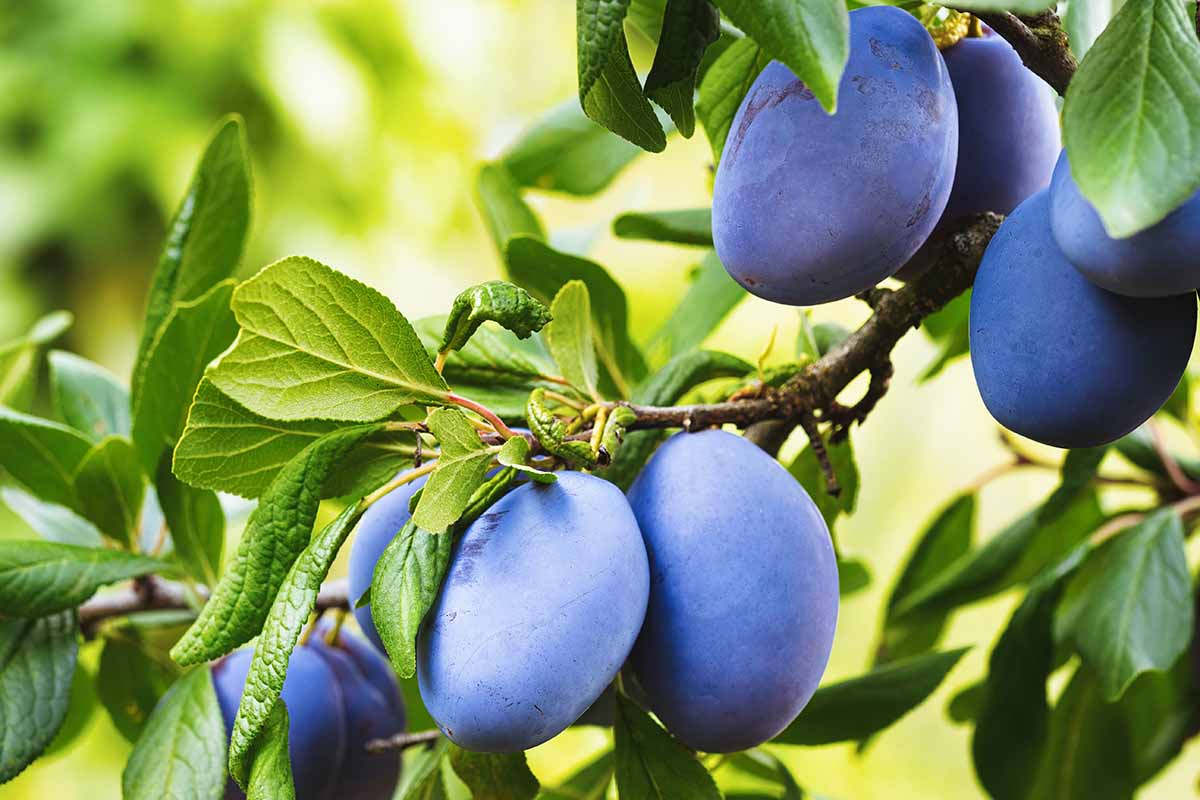
We link to vendors to help you find relevant products. If you buy from one of our links, we may earn a commission.
All plum trees are susceptible to the following nine pests, but stressed trees are even more likely to suffer ill effects.
So it’s important to do your best to keep your plum trees happy. If you need a primer about how to care for plum trees, read our guide.
You might also want to go over our guide to how and when to spray plums for pests.
Then, come back here, and we’ll talk about the creepy crawlies that are out there eyeing your trees.
Here is the “most unwanted” list that we’ll be going over:
Our first plum pest is itty-bitty, but don’t let that fool you. They can cause big problems.
1. Drosophila
The spotted wing drosophila (Drosophila suzukii) feeds on the fruits of grapes, stone fruits, including plums, and brambles.
The adults are little fruit flies, but unlike those that devour overripe fruits on your countertop, these pests attack fruit that is just ripe and still on the plant.
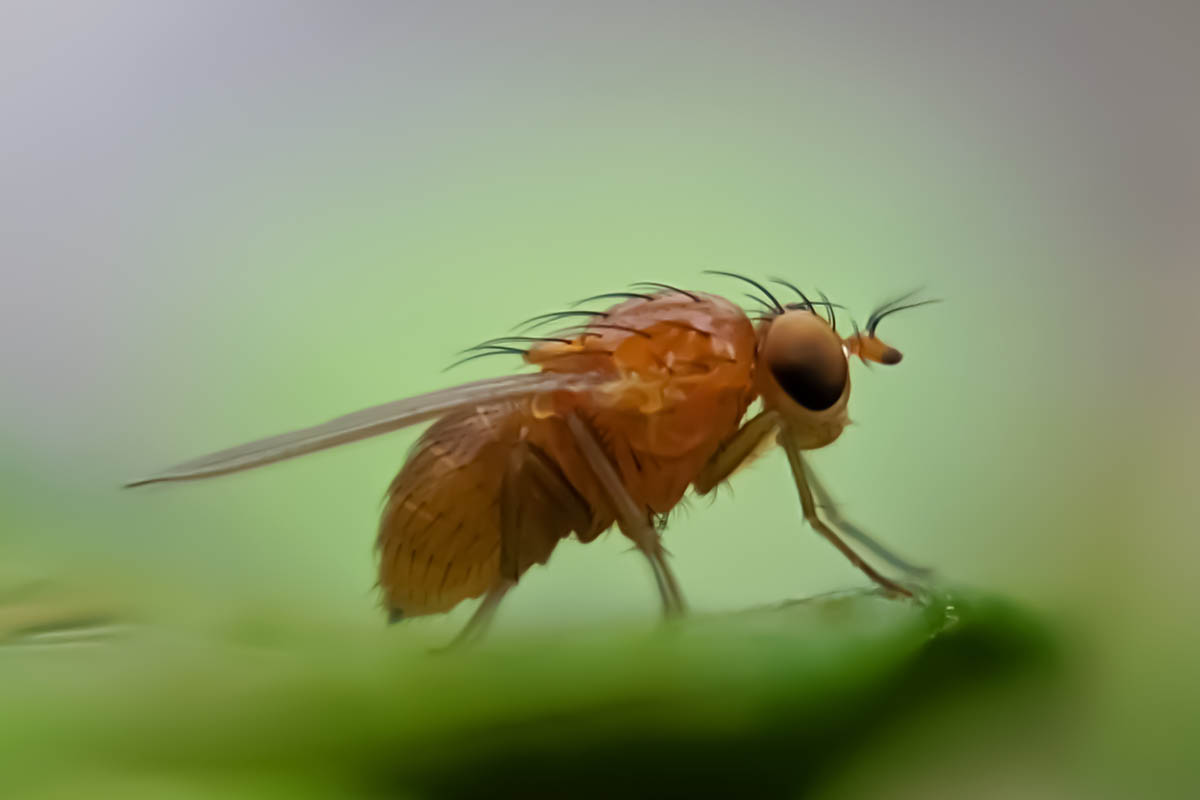
The adults lay their eggs inside the fruit, so not only will there be feeding marks on the skin of the plums, but you might take a bite and get a mouthful of larvae. I don’t know what more motivation you need to try and avoid them.
These pests appear in the summer to feed and breed on plums, and then overwinter as adults to start the cycle over again.
They won’t lay their eggs in healthy plums, but they’ll look for the tiniest hole made by thrips, aphids, or mechanical damage, and that’s when they strike. The female lays her eggs, at the same time injecting a bacteria in the Acetobacter genus that causes the fruit to rot.
Even if this doesn’t cause the plum to rot, it’s likely her larvae are feeding and thriving in there.
If you notice any damaged plums, remove them immediately to deny the pests a place to lay their eggs. You can also put netting, tunnels, or cloths over your tree or shrub if it’s small enough.
You can also use a pesticide, but make sure to apply it when the pollinators aren’t out and about – an evening on a calm day is the ideal time to minimize impact on beneficial insects.
Keep in mind that pesticide applications will only tackle the adults, not any larvae already present in the fruit.
Spinosad and pyrethrins both work to kill the adults. For effective control, I recommend alternating between two products and applying every two weeks until the end of August. These pests reproduce quickly, so you need to stay on top of them.
Traps are useful both for monitoring and control of pest populations. Put out one or more traps near your plum trees in the late spring and keep an eye on how many pests you’re collecting.
If you seem to be trapping more and more, it’s time to break out the insecticides.
Grab a kit, which includes both a lure and trap, at Arbico Organics in packs of one or two. You can also buy replacement traps and lures if you only need one element.
2. Flatheaded Borers
Borers can be a problematic pest in plums.
Pacific (Chrysobothris mali) and apple-tree flatheaded borers (C. femorata) look similar as adults, the beetles measuring about half to three quarters of an inch long, with olive-green, dark gray, brown, and bronze coloring, and flattened heads.
The larval form has a flat and swollen thorax and a flattened head.
Both the larvae and the adults live and overwinter on the plum tree, though they do move in and out of the soil surrounding the planting area.
They typically target stressed trees, and the adults eat through the bark and into the sapwood, where they disturb the phloem, or the straw-like structures that move water in the tree.
A heavy infestation can completely girdle branches or trunks. These pests tend to hang out on the sunniest side of trees, so look for colored depressions and girdled branches on those areas first.
The symptoms can look similar to damage from other borer species, with frass-filled holes, discolored depressions, and weeping sap. You will also see dead branches and loose bark.
Woodpeckers love these pests and carpenter ants eat the larvae. But if you are facing a large infestation, relying on natural predators isn’t enough.
The first step is to do what you can to keep your plum tree healthy. Remember, these pests are attracted to weak or stressed specimens because they can’t feed on trees that have healthy, growing tissue full of sap.
You should also clean up any weeds and debris from around your plum trees to expose the larvae and beetles and deprive them of overwintering sites.
You can also use sticky traps wrapped around the trunk to catch any adults or larvae climbing up or down the trunk.
You can grab a roll of sticky blue adhesive on four, seven, or 11-foot widths and 328-foot lengths at Arbico Organics.
Examine the trunk for holes and use a knife to cut away a little bit of the bark at the area. Then, use a wire to stab and remove the larvae.
There isn’t an effective insecticide treatment for the larvae once they get under the bark.
If your plum tree is heavily infested and has multiple dead or dying branches, there isn’t much you can do.
You can try removing the most infested branches, but it’s probably better to just remove the specimen entirely.
3. Peach Twig Borer
Peach twig borers (Anarsia lineatella) aren’t super common, and they can be a pain in the butt some years and no big deal in others.
The adults are moths with mottled gray and brown wings, but they aren’t the ones that do the damage.
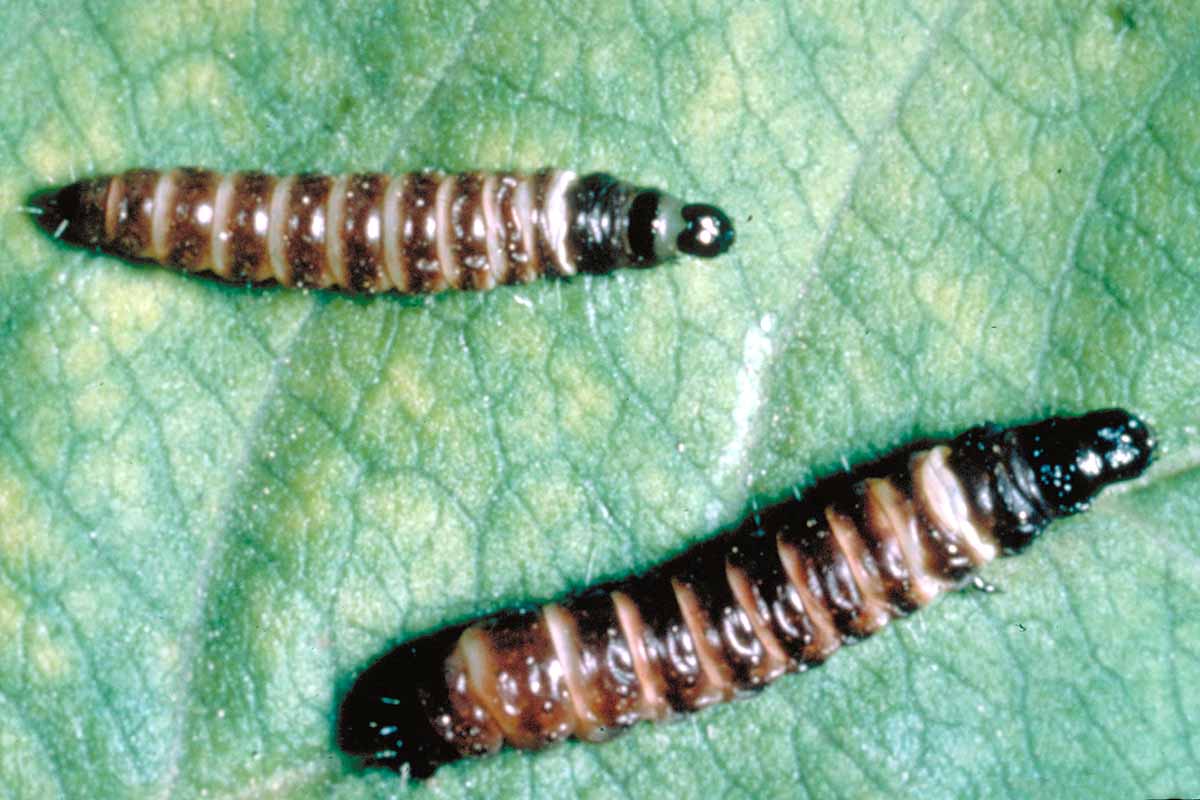
The white larvae emerge in the spring from their nests on the plum trees to tunnel into the young, growing shoot tips. As they age, they turn dark brown with white bands and are half an inch long.
The twigs they tunnel into eventually die, and ooze sap out of the tips.
Then, the larvae pupate, adults emerge, and the cycle continues with a second generation. This time, the larvae tunnel into the developing fruit, entering near the stem.
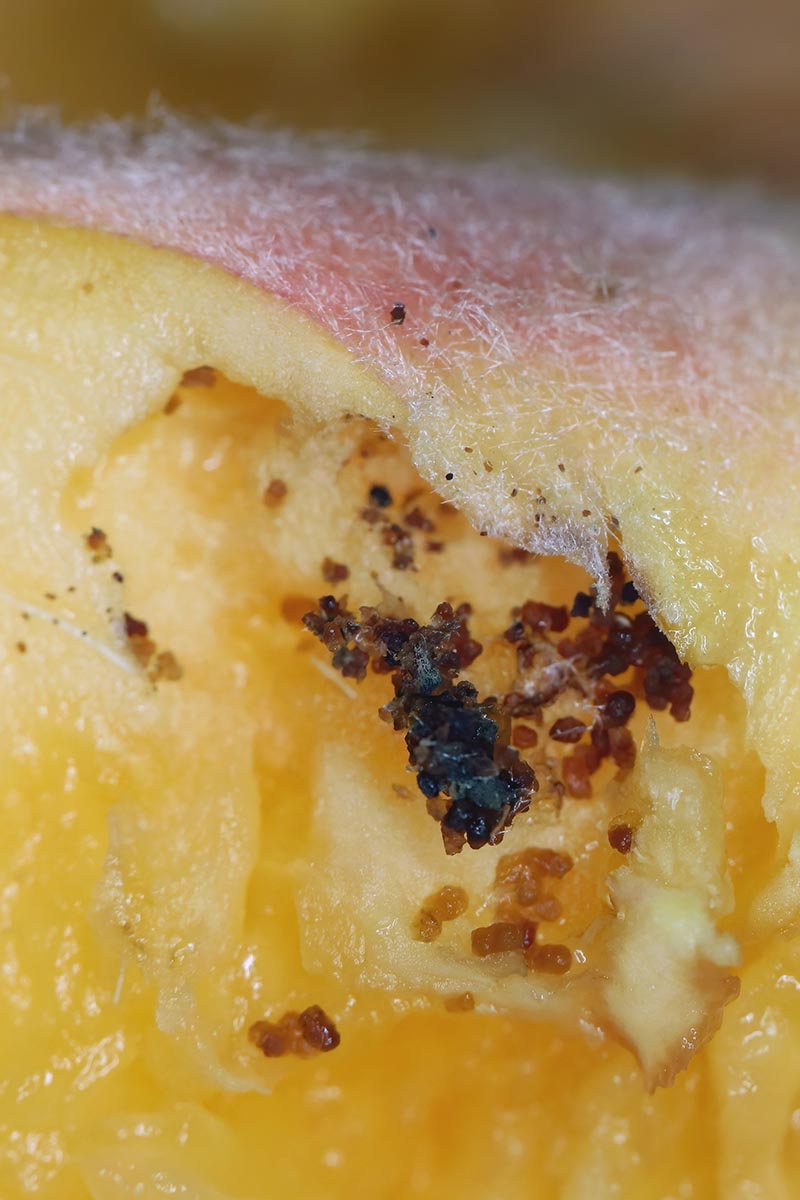
Since the larvae become active based on environmental temperature changes, you’ll need to talk to your local extension office to figure out when to treat your plants.
To control this plum pest, spray your trees with dormant oil before they bud out in the late winter or early spring. This will smother some of the overwintering larvae.
Then, grab a product that contains the beneficial bacteria Bacillus thuringiensis v. kurstaki (Btk).
Something like Bonide’s Thuricide is a good option and can be purchased at Arbico Organics in quart or gallon ready-to-use or eight- or 16-ounce concentrate.
Spray according to the schedule suggested by your local extension.
You can learn more about peach twig borers in our guide.
4. Peach Moth
The peach moth (Grapholita molesta), which also goes by the outdated epithet oriental fruit moth, has become an increasingly significant problem in North America in recent years.
They can produce up to six generations per year, which means a pretty steady infestation of the damaging larvae.
The adults are gray night-flying moths about half an inch long, but once again it’s the larvae that cause all the problems. They are white with a black heads and eventually mature to about half an inch long with pink bodies and brown heads.
The larvae bore into the shoots of the plum tree and will also feed on the fruit, entering at the stem end or in protected areas such as where two fruits touch – you did remember to thin your plums, right?
If you’ve ever dealt with codling moths on apples, the damage looks the same in your plums.
Beyond the damage they do to the fruit, infested twigs will also have wilted leaves along with a gummy sap oozing out.
The plum tree responds by sending out lateral shoots below where the larvae stopped tunneling, which means a long-term infestation can result in some strangely bushy trees.
Your local extension office will calculate the number of degree hours between 45 and 90°F, which is when the larvae develop. You can reach out to them to find out when this is and when to start treating your plum tree.
Commercial orchards rely on sprayable pheromones to disrupt the breeding phase and have great success, but it only works on the adults, not the larvae.
5. Peachtree Borers
The greater peachtree or clearwing borer (Synanthedon exitiosa) is the most common and destructive borer to impact plums, and they also attack almonds, apricots, cherries, nectarines, and peaches.
This is a nasty pest to have in your garden.
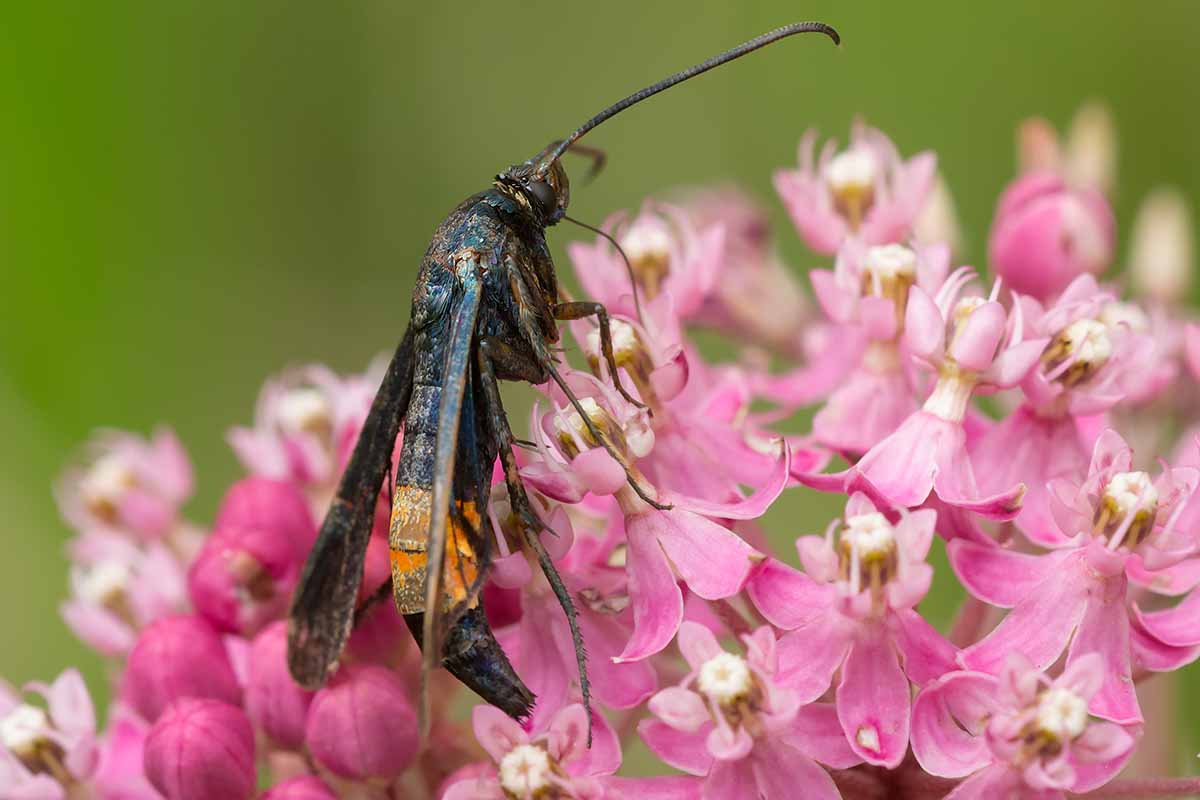
The adults are moths with translucent wings that stretch up to an inch and a quarter when open, and steel blue bodies with an orange band. They are native to North America.
The females lay up to 600 eggs each in late spring and in a week or so the eggs hatch and the reddish-brown to pale white larvae emerge. They tunnel through the bark near the soil level and into the cambium layer.
When they’re present, you’ll see dying branches and loose bark at the soil level. Leaves might also turn yellow and growth can be stunted.
You’ll often notice sawdust-like frass, perhaps along with oozing sap coming out of the bore holes. Keep an eye out for pupal cases around the base of the tree, too.
It helps to keep any plants, whether cultivated or weeds, away from the base of the plum trees.
You’re going to need a multi-pronged approach to address a peachtree borer infestation. The first is to use beneficial nematodes.
Both Steinernema carpocapsae and Heterorhabditis bacteriophora are effective against the larvae.
NemAttack Beneficial Nematodes
Grab a combo pack of 10, 50, 250, or 500 million of these helpful roundworms from Arbico Organics, add water, and apply the mix to the trunk of your plum tree.
You really want to work it into the cracks and openings in the trunk.
Next, use an insecticide to kill the eggs. You’ll need a product that contains spinosad or pyrethrins and apply it every ten days starting in the summer.
You can find eight-ounce, pint, quart, or gallon quantities of Monterey Garden Insect Spray, which contains spinosad, at Arbico Organics.
6. Plum Curculio
Growers in western US don’t have to worry about the plum curculio (Conotrachelus nenuphar) so much, but those east of the Rockies need to be vigilant.
This dark brown beetle is a true weevil with a long snout and it isn’t very large, staying under a third of an inch long, but it does some seriously outsized damage.
The adults hang out underground and in plant debris during the winter.
When temperatures warm up in the spring, they crawl or fly up into the tree and start to feed on the tiny developing fruits.
As the fruits grow bigger, the females poke holes in the skin and lay their eggs. One female can lay hundreds of eggs. They also lay eggs in apples, cherries, peaches, pears, and nectarines.
Once the eggs hatch, the grubs get to work. The third-of-an-inch-long white grubs have small brown heads, and they tunnel into the center of the fruit to feed.
This feeding not only renders the fruit inedible, but it can also cause fruit drop.
To tackle these weevils, you once again need to employ a multi-pronged approach. First, lay a tarp down under the plum tree and give it a good shake.
The beetles don’t have great grip, so they’ll topple out and land on the tarp. Do this in the morning when they’re still sluggish from the nighttime, and you’ll have even better results. Then, fold up the tarp and dispose of the beetles.
You should always clean up any fallen fruit because they could be filled with eggs or larvae. Also, it helps to cultivate the soil under the plum trees in the spring to expose any larvae that have fallen to the soil.
Finally, if this doesn’t address the problem, you’ll need to spray repeatedly in the spring when the adults become active but before they have a chance to lay eggs.
The first spray should be applied when the flower petals fall from the tree. The next should be a week later, and the final one a week after that.
Use a product that contains pyrethrins or the beneficial fungus Beauveria bassiana. Or better yet, both!
A product like BotaniGard Maxx contains pyrethrins, which are made from chemicals found in chrysanthemum flowers that are toxic to insects as well as B. bassiana, which parasitizes pest insects.
Pick up a quart, gallon, or two-and-a-half gallon at Arbico Organics.
7. San Jose Scale
While other scale species might feed on plums, nine times out of 10 it will be San Jose scale (Quadraspidiotus perniciosus) that infests your plum trees.
These pests are oval or disk-shaped and grayish in color.
The adults are fairly flat and don’t move, so you might not even notice they’re on your tree unless you look closely. The mobile yellow crawlers usually also go unnoticed.
These pests use their sucking mouthparts to feed on bark and twigs, injecting a damaging toxin as they do.
Large infestations can cause the tree to lose vigor and produce a reduced harvest or deform the fruit. It can even kill young or weak specimens.
It’s usually the sticky honeydew the pests secrete or the symptoms on the plum tree such as yellowing foliage, drying shoots, weak growth, or reduced size and number of fruits, that tips us off that something is wrong.
If you peel back the bark on green, pliable branches, you’ll find red tissue underneath.
A treatment with dormant oil in the late winter can help suppress populations of this plum pest. You can also prune off heavily infested branches.
Once the adults mature, they are covered in a waxy coating that protects them from pesticides, so these are ineffective.
Learn more about how to deal with scale in our guide.
8. Speckled Green Fruitworm
It’s lime green and speckled! It’s the speckled green fruitworm (Orthosia hibisci).
These pests overwinter in the soil and are active in the spring, when the larvae emerge and feed on leaves, flowers, and the developing fruit, leaving ragged holes and dents.
To identify these pests, hold a shallow tray or piece of paper under the plum tree and shake the limb. They’ll fall right off.
Spray a product containing spinosad or Bacillus thuringiensis when the fruit starts developing. Either product is highly effective against these soft-bodied worms.
9. Western Flower Thrips
These tiny critters (Frankliniella occidentalis) are more of a nuisance than a major problem, though they can spread diseases that cause much bigger issues.
However, in large numbers, they can cause serious damage to the fruits, especially in thin-skinned cultivars.
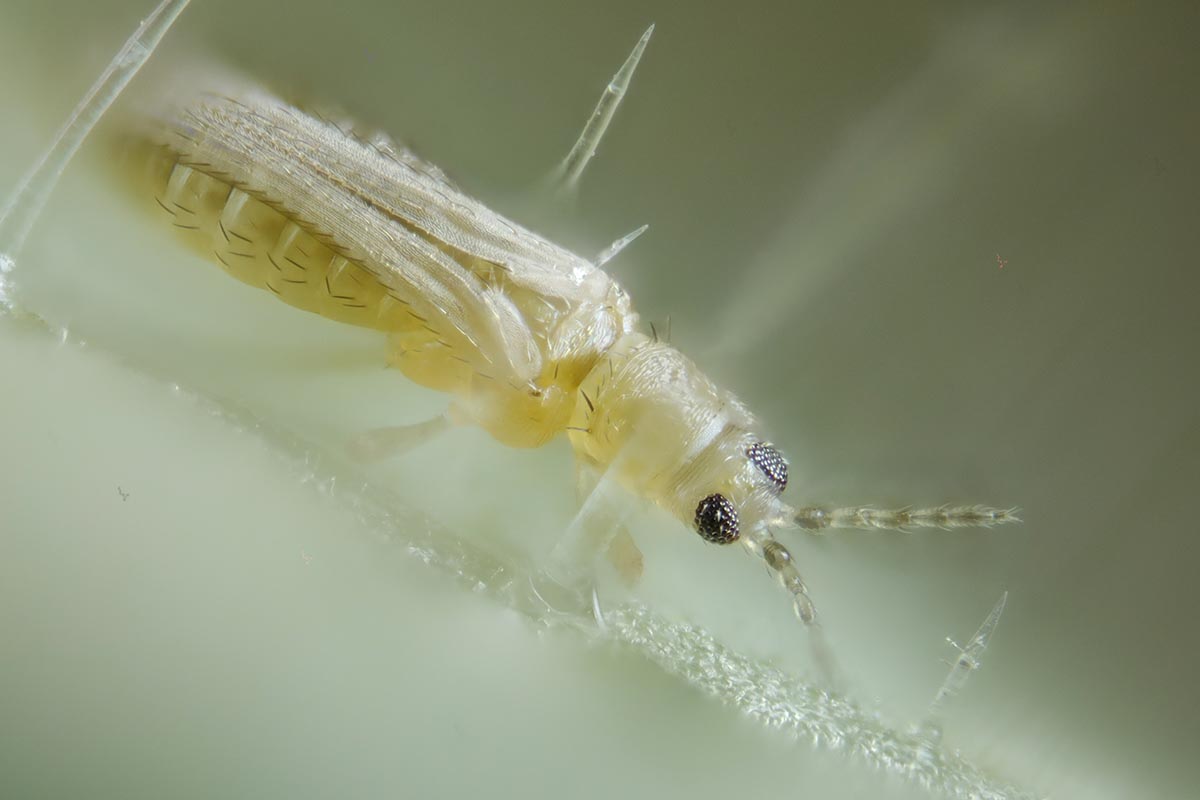
The yellowish-brown insects are about 0.05 of an inch long with clear wings, though you’ll have to get close to see them. The immature form looks the same but lacks wings.
These sap-sucking plum pests feed on the flowers and young fruit, causing scarring on the skin. The feeding can also lead to deformed fruit.
Unlike borers, which hide inside the bark of trees, and scale, which have a protective coating, thrips are exposed, making them easier to get rid of.
Grab your spinosad and apply it thoroughly to the trees at petal drop. That should take care of the adults and any eggs or nymphs.
Learn more about how to deal with thrips in our guide.
Stop Pestering Me!
I’ll keep my fingers crossed that you never experience plum pests, but since you’re here, I’m guessing that something is visiting your trees and it’s causing concern.
Remember, keeping your trees healthy will go a long way toward keeping pests at bay or helping them survive an infestation.
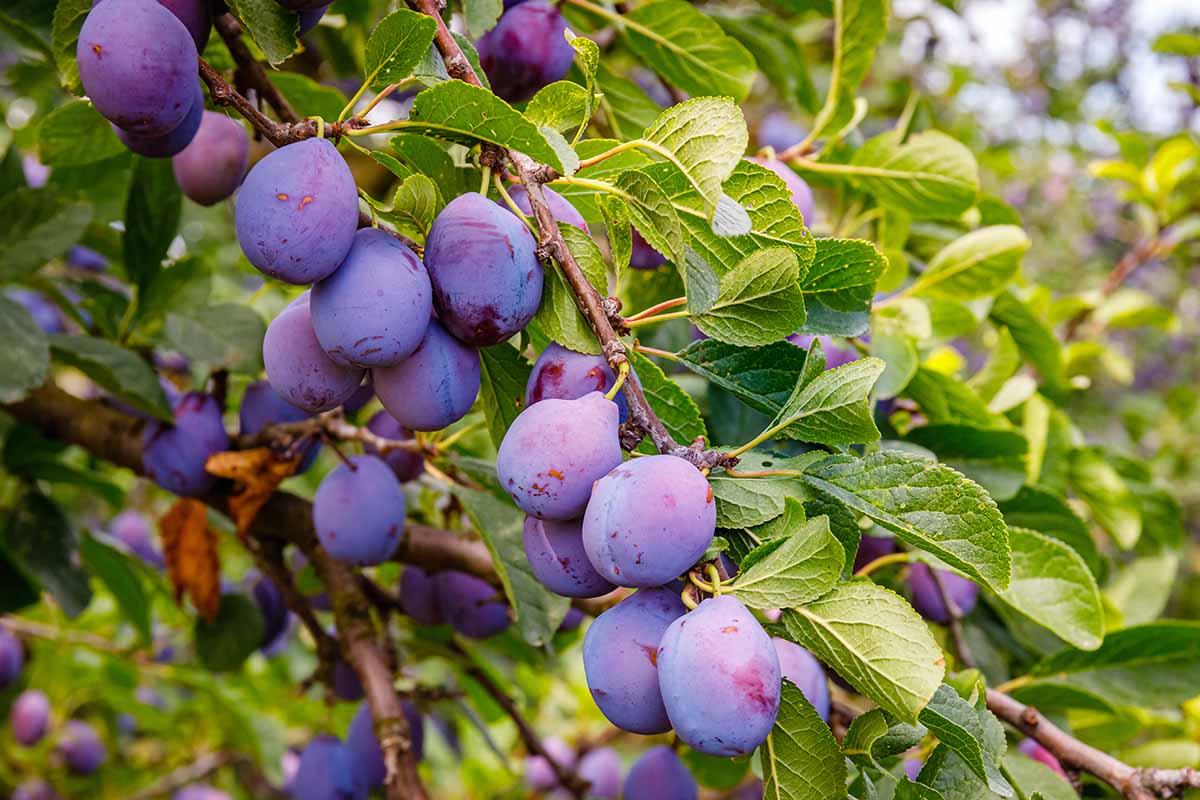
Is something bugging your trees? What symptoms are you seeing? Do you need any additional guidance? Let us know in the comments section below.
And for more information about growing and caring for plum trees, read these guides next:


